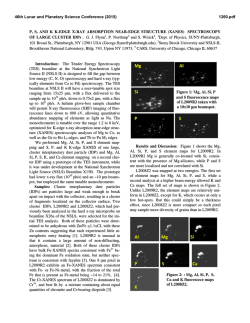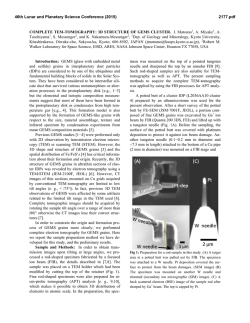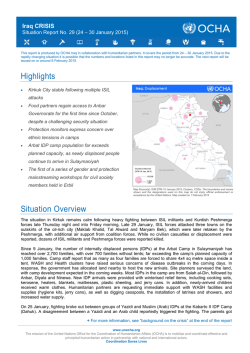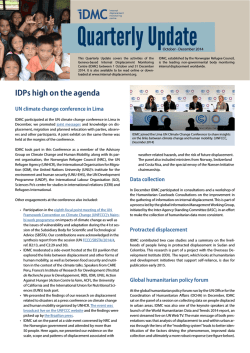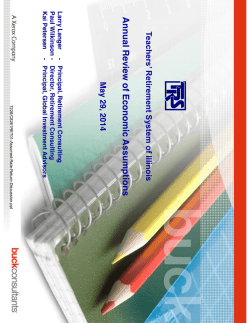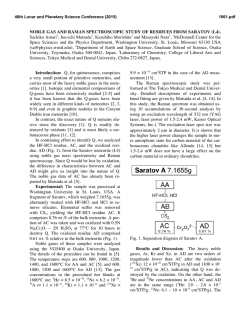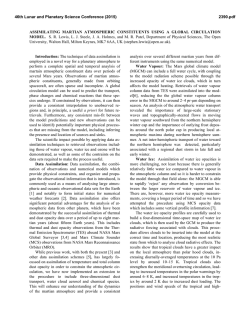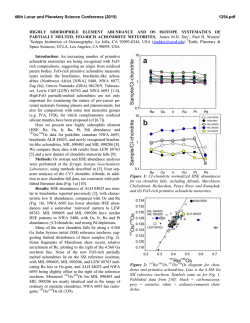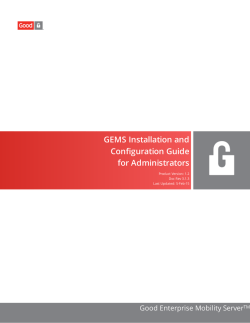
SIZE MATTERS: ASSESSING DEGREE OF PRESERVATION OF
46th Lunar and Planetary Science Conference (2015) 2541.pdf SIZE MATTERS: ASSESSING DEGREE OF PRESERVATION OF INTERPLANETARY DUST AND MICROMETEORITES. H. A. Ishii, Hawaii Insitute of Geophysics and Planetology, University of Hawaii at Manoa, 1680 East-West Rd. POST 602, Honolulu, HI 96822, USA. ([email protected]). Introduction: NASA’s Stardust mission returned the first samples of a known comet, 81P/Wild 2 [1], permitting comparison with chondritic porous interplanetary dust particles (CP IDPs) also believed to originate from comets [c.f. 2]. Unfortunately, hypervelocity capture of Wild 2 dust in silica aerogel severely altered the fine-grained fraction; however, large (few to 10s of microns) refractory Wild 2 grains survived capture relatively intact, and surviving CAIs and chondrule fragments [3-7] provide a compelling link to carbonaceous chondrites (CCs) and unprecedented insight into grain transport in the solar nebula [1]. Linking Wild 2 to specific classes of CCs, IDPs or micrometeorites (MMs) has proven significantly more challenging. Comparisons with fine-grained materials, like CP IDPs, are particularly difficult because the loss and damage to the fine-grained fraction was so severe – although some authors argue CP IDP-like material must have been present [8,9]. GEMS and enstatite (En) whiskers and platelets with specific crystal habit are uniquely characteristic of CP IDPs [10], and their discovery in ultracarbonaceous micrometeorites (UCMMs) collected from Antarctic snow and ice establishes that UCMMs are part of the CP IDP family [11,12]. Hypervelocity capture, however, complicates positive identification of GEMS in Wild 2 dust due to production of GEMS-like objects through ablative interactions of comet dust, including Fe-sulfides, with the silica aerogel collection medium [13]. Although some researchers argue the presence of GEMS in Wild 2 from chondritic average composition data [14] and others report En whiskers and platelets [15], there are no robust identifications of GEMS or En whiskers and platelets of appropriate crystal habit yet. Fe oxidation state comparisons also are constrained by severe redox excursions during capture, especially to the finegrained fraction [16]. The altered state of the Wild 2 sample raises questions about the state of preservation of CP IDPs (and UCMMs) with which we are comparing Wild 2. There is frequently an unspoken assumption that anhydrous CP IDPs and MMs have been neglibibly altered in the terrestrial environment, but CP IDPs also comprise a biased sample set due their manner of capture, first by atmospheric entry and then by collection. In addition to possible decoupling of large single-mineral grains from more fragile aggregates during atmospheric entry, there are less obvious, but significant, differences that impact the fidelity of CP IDP datasets used for com- parisons with other meteoritic materials. All IDPs are frictionally heated for several seconds during atmospheric entry, most >500°C, and the largest particles are more likely to have been most strongly heated. Researchers have increasingly studied large cluster IDPs (typically >50 to 100s of microns in diameter) because (a) they are easier to handle, (b) H and N isotope anomalies suggestive of surviving molecular cloud material are larger and more common [17], (c) their interiors are presumed to be less heated than their outer surfaces during atmospheric entry, and (d) UCMMs provide a new resource of large cluster CP IDP-like material. Is bigger actually better? We compare characteristics of small IDPs with cluster IDPs collected in the stratosphere and also consider ultracarbonaceous micrometeorites (UCMMs) collected in snow and ice in the Antarctic. We show that some temperaturesensitive minerals in small (<20 µm) CP IDPs can differ significantly from those of larger (>50 µm) cluster IDPs and UCMMs, and we describe new analytical approaches for investigating evidence of thermal modification below the solar flare track erasure temperature. Results and Discussion: Atmospheric entry heating effects in CP IDPs and UCMMs may be readily evident in the presence of magnetite rims (e.g. Fig. 1c), vesicles in carbonaceous material, loss of volatiles and melted morphologies of silicates and sulfides. In those particles that do not show obvious signs of atmospheric entry heating, the presence of solar flare tracks in crystalline minerals is commonly used as an indicator that temperatures have not exceeded the solar flare track erasure temperature, ~650°C [18]. For larger cluster CP IDPs and UCMMs, however, solar flare tracks are not reliable as a thermal indicator be- Figure 1: GEMS that have undergone differing degrees of thermal modification. (a) GEMS in a weakly heated small CP IDP with sulfides distributed thoughout the interior. (b) Moderately heated GEMS from the interior of a UCMM with sulfides decorating the GEMS surface. (c) Strongly heated GEMS from the outer surface of a large cluster IDP with magnetite rims from thermal oxidation of sulfides that migrated to the GEMS surface. 46th Lunar and Planetary Science Conference (2015) cause these particles may be sufficiently large that their interiors are shielded so that most particle volume never contained solar flare tracks regardless of the temperatures experienced. Even in small CP IDPs that retain solar flare tracks, little is known about modifications occurring at lower temperatures. Sulfides and GEMS are potential indicators of thermal alteration below the solar flare track erasure temperature. Sulfide-decorated GEMS are more abundant in the large cluster CP IDPs and UCMMs likely to be strongly heated during atmospheric entry and less abundant in small CP IDPs (Fig. 1). Heating experiments in air of a small (<20 µm diameter) track-rich IDP, to simulate atmospheric entry, have shown melting of sulfides in GEMS at 300-400°C and migration to surfaces [20] contradicting interpretation of sulfidedecorated GEMS as evidence of nebular condensation [21]. GEMS in UCMMs may also suffer leaching due to snow/ice exposure. Figure 2: Electron microdiffraction patterns from a sulfide in small CP IDP W2070 8D. (a) Initial pattern shows two crystal structures, one hexagonal, the other, a cubic spinellike sulfide. (b) Pattern after extended electron-beam heating indicates transformation of the cubic into higher temperature hexagonal pyrrhotite [from 19]. Sulfides of several different crystal structures have been observed in CP IDPs, including one that transforms to a different structure with mild heating in an electron-beam (Fig. 2) [19]. Where present, the cubic (Fd3m) structure can reduce estimates of maximum temperature experienced to well below 500°C. Low-loss electron energy loss spectroscopy (EELS), facilitated by monochromated and aberrationcorrected (scanning) transmission electron microscopes, now allows detection of solar-wind implanted low-Z elements that are highly susceptible to loss by heating. We have detected H and He implanted in silicate mineral surfaces in small CP IDPs (Fig. 3). Lowloss EELS can be applied to search for retained H and He to indicate which particles suffered minimal heating during atmospheric entry. Finally, it should be noted that volatile organics, the most susceptible component to thermal and oxidation state alteration, are likely modified by atmospheric entry well below solar flare track erasure temperatures. 2541.pdf Figure 3: Retention of He and H in silicate minerals is confirmed by the peaks at their respective K-edges in low-loss EEL spectra. Indeed, the thermal spike on entry may alter organic chemistry, for example, oxidation changing the ratio of C=C to C=O bonding commonly studied by XANES [e.g. 22]. Thermally-initiated mobilization could also lead to local segregation as a function of molecular weight and volatility, and if H and N isotope anomalies are associated with mobile carriers, then this could explain their higher abundance in large cluster IDPs [17]. Experiments on the response of isotope anomalies in CP IDP organics to pulse heating are merited. References: [1] Brownlee D.E. et al. (2006) Science 314, 1711-1716. [2] Bradley J.P. (2014) in Treatise on Geochemistry, vol. 1, 287-308. [3] Nakamura T. et al. (2008) Science 321, 1664-67. [4] Zolensky M.E. (2006) Science 314, 1735-39. [5] Simon S.B. et al. (2008) Meteorit. Planet. Sci. 43, 1861-1877. [6] Matzel J.E.P., et al. (2010) Science 328, 483-486. [7] Joswiak D.J. (2014) Geochim. Cosmochim. Acta 144, 277-298. [8] Leroux H. (2012) Meteorit. Planet. Sci. 47, 613-622. [9] Brownlee (2014) Ann. Rev. Earth Planet. Sci. 42, 179-205. [10] Bradley J. P. (1994) Science 265, 925-929. [11] Noguchi T. et al. (2015) Earth Planet. Sci. Lett. 410, 1-11. [12] Dobrica E. et al. (2012) Geochim. Cosmochim. Acta 76, 68-82. [13] Ishii H.A., et al. (2008) Science 319, 447-450. [14] Leroux H. and Jacob D. (2013) Meteorit. Planet. Sci. 48, 1607-1617. [15] Stodolna J. et al. (2014) Earth Planet. Sci. Lett. 388, 367-373. [16] Stodolna, J. et al. (2013) Geochim. Cosmochim. Acta 121, 1-16. [17] Messenger S. (2000) Nature 404, 968-971. [18] Bradley J.P. et al. (1984) Science 226, 1432-34. [19] Dai Z.R. & Bradley J.P. (2001) Geochim. Cosmochim. Acta 65, 3601-12. [20] Bradley J. P. et al. (2014) LPS XXXVIII, Abstract #1178. [21] Matsuno, M. J. et al. (2014) Meteorit. Planet. Sci. Suppl., Abstract # 5079. [22] Flynn G.J. et al. (2013) Meteorit. Planet. Sci. Suppl., Abstract #5197. Acknowledgements: Thanks go to J.P. Bradley for useful discussions. This work was funded by NASA’s Laboratory Analysis of Returned Samples Program.
© Copyright 2026
